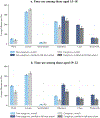Youth Caregivers of Adults in the United States: Prevalence and the Association Between Caregiving and Education
- PMID: 38785364
- PMCID: PMC11539003
- DOI: 10.1215/00703370-11383976
Youth Caregivers of Adults in the United States: Prevalence and the Association Between Caregiving and Education
Abstract
A growing proportion of individuals adopt family caregiving roles. Family caregivers are the primary providers of long-term care in the United States yet limited federal policy supports exist, despite the known negative impacts of caregiving. There is also limited information about the prevalence of youth/young adult caregivers and the impacts of caregiving at formative ages in the United States. Our objective is to estimate the prevalence of youth caregivers and examine the association of caregiving with educational investments. We use the American Time Use Survey (2013-2019) to identify and describe youth caregivers (aged 15-18) and young adult caregivers (aged 19-22) and compare them with non-caregiving peers. We estimate that there are approximately 1,623,000 youth caregivers and 1,986,000 young adult caregivers, corresponding to 9.2% and 12.7% of these age groups, respectively. However, there is a wide range in the estimated prevalence per year, from approximately 364,000 to 2.8 million youth caregivers and from 353,000 to 2.2 million young adult caregivers, depending on caregiver definition. Unlike adult caregivers, we find that young men and women were nearly equally likely to provide care. We also find that non-White individuals are disproportionately represented as youth caregivers. Compared with non-caregiving peers, both youth and young adult caregivers are less likely to be enrolled in school and, among those enrolled in school, spend significantly less time on educational activities. Considering the association of caregiving among youth/young adults and education, policies supporting youth and young adult caregivers are critical.
Keywords: Caregivers; Educational status; Family caregivers; Informal caregivers; Youth.
Copyright © 2024 The Authors.
Figures


Similar articles
-
Prevalence of Informal Caregiving in States Participating in the US Patient Protection and Affordable Care Act Balancing Incentive Program, 2011-2018.JAMA Netw Open. 2020 Dec 1;3(12):e2025833. doi: 10.1001/jamanetworkopen.2020.25833. JAMA Netw Open. 2020. PMID: 33320262 Free PMC article.
-
Comparison of informal caregiving by black and white older adults in a community population.J Am Geriatr Soc. 2000 Dec;48(12):1612-7. doi: 10.1111/j.1532-5415.2000.tb03872.x. J Am Geriatr Soc. 2000. PMID: 11129751
-
The effectiveness of school-based family asthma educational programs on the quality of life and number of asthma exacerbations of children aged five to 18 years diagnosed with asthma: a systematic review protocol.JBI Database System Rev Implement Rep. 2015 Oct;13(10):69-81. doi: 10.11124/jbisrir-2015-2335. JBI Database System Rev Implement Rep. 2015. PMID: 26571284
-
Projected Costs of Informal Caregiving for Cardiovascular Disease: 2015 to 2035: A Policy Statement From the American Heart Association.Circulation. 2018 May 8;137(19):e558-e577. doi: 10.1161/CIR.0000000000000570. Epub 2018 Apr 9. Circulation. 2018. PMID: 29632217 Review.
-
Male Caregivers: Shifting Roles Among Family Caregivers.Clin J Oncol Nurs. 2019 Feb 1;23(1):E17-E24. doi: 10.1188/19.CJON.E17-E24. Clin J Oncol Nurs. 2019. PMID: 30681996 Review.
Cited by
-
Adolescents' caregiving for family: Associations with mental health and academic performance.J Res Adolesc. 2025 Sep;35(3):e70045. doi: 10.1111/jora.70045. J Res Adolesc. 2025. PMID: 40586181
-
Young Adult Caregivers for Older Family Members: Setting a New Research Agenda.Innov Aging. 2024 Dec 28;9(4):igae112. doi: 10.1093/geroni/igae112. eCollection 2025. Innov Aging. 2024. PMID: 40231160 Free PMC article. Review.
-
A Perspective on Making "Invisible" Care Visible Through Time Use Data.J Aging Soc Policy. 2025 Jul 24:1-16. doi: 10.1080/08959420.2025.2528587. Online ahead of print. J Aging Soc Policy. 2025. PMID: 40704887
References
-
- AARP & National Alliance for Caregiving. (2020). Caregiving in the United States 2020 (Report). Washington, DC: AARP. Retrieved from https://www.caregiving.org/wp-content/uploads/2020/08/AARP1316_ExecSum_C...
-
- Al-Aly Z, Xie Y, & Bowe B (2021). High-dimensional characterization of post-acute sequelae of COVID-19. Nature, 594, 259–264. - PubMed
-
- Altintas E, & Sullivan O (2017). Trends in fathers’ contribution to housework and childcare under different welfare policy regimes. Social Politics, 24, 81–108.
-
- Armstrong-Carter E, Johnson C, Belkowitz J, Siskowski C, & Olson E (2021). The United States should recognize and support caregiving youth. Social Policy Report, 34(2), 1–24.
-
- Arora K, & Wolf DA (2014). Is there a trade-off between parent care and self-care? Demography, 51, 1251–1270. - PubMed
MeSH terms
Grants and funding
LinkOut - more resources
Full Text Sources
Medical
